The lower stretch of the Bajhang River (八掌) divides Chiayi County from Tainan City, and life on either side of the waterway remains quite traditional. In this corner of the Chianan Plain (嘉南平原), fishing, aquaculture and agriculture are important components of the rural economy
Every village has at least one temple representing popular religion, yet there’s also plenty of evidence to support a conclusion drawn by Pew Research in 2014: After Singapore, Taiwan is the most religiously diverse society in the world. In Western countries, one is unlikely to find a mosque or a Hindu temple in a rural area. In Taiwan, by contrast, there are Christian places of worship everywhere — and no friction, or none worth speaking of, between monotheistic Taiwanese and their polytheistic neighbors.
Beimen District (北門) in Tainan has what some reckon to be the country’s most-visited religious site, Nankunshen Daitian Temple (南鯤鯓代天府). At the same time, Beimen is the location of a museum that celebrates the work of a Christian medical mission.
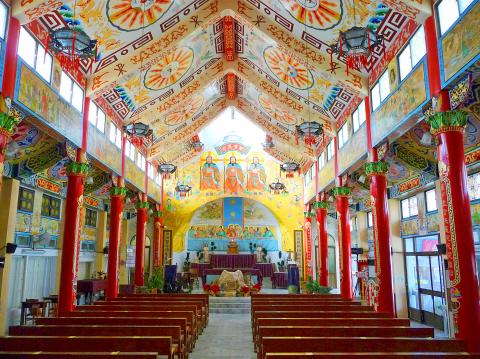
Photo: Steve Crook
Taiwan Black-foot Disease Socio-Medical Service Memorial Hall (台灣烏腳病醫療紀念館) is next door to the former clinic that local doctor and lay preacher Wang King-ho (王金河, 1916–2014) operated from 1960 to 1986. Wang devoted himself to treating the peculiar local health problem known as black-foot disease (BFD). Victims of this chronic progressive disease, which was caused by drinking well-water contaminated with arsenic, suffered great pain; their feet often turned black, and many had extremities amputated. Now the afflicted areas are supplied with water from elsewhere, BFD is no longer a threat.
The Presbyterian Church with which Wang was affiliated is at 31 Yonglong Borough (永隆), just up the road from the memorial hall at number 27. It’s an elegant building, but less intriguing than another Presbyterian landmark 20km to the northeast.
DONGHOULIAO CHURCH
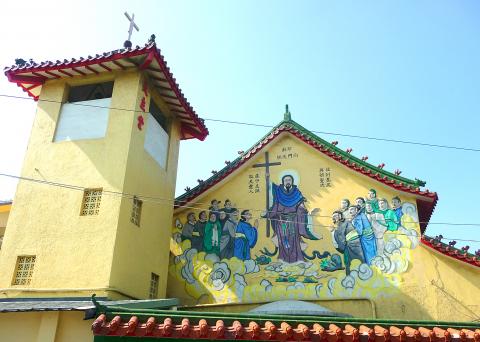
Photo: Steve Crook
Donghouliao Church (東後寮教會) is in Chiayi County’s Yijhu Township (義竹). If you’re coming from the south, you’ll find it on the right side of Highway 19, a short distance north of the 94km marker. If you’re approaching from the north, look for it on the same side of the road as, and just past, Guangrong Elementary School (光榮國小).
The church was founded in 1917 and grew rapidly. By 1928, about 300 people were attending services. The main attraction here is the redbrick chapel near the main road. Built in 1926 to a simple rectangular design, it lacks a steeple, and is no taller than many of the single-story houses in the village. The buttresses along the sides and at the back were added after the building sustained damage in earthquakes in 1927, 1930 and 1935.
If you stand in front of the old church you’ll see a modern activity center on the left, and behind that the current church. The latter, built in the 1960s, has about three times the capacity of the redbrick hall. According to the Web site of the Presbyterian Church in Taiwan, as of last year the congregation numbered 162, with women outnumbering men.

Photo: Steve Crook
Photos of the facade taken in the 1930s show the English words, “The Christian Church of Togoryo.” These were erased long ago, perhaps because that toponym was a relic of Japanese rule. Inside, above where the altar was once placed, there’s a four-character inscribed tablet. Unlike similar tablets in local temples, this beautiful item isn’t besmirched by soot and grime from incense smoke. From right to left it reads “Christ’s teachings” (基督聖教).
A report in September last year on the Taiwan Church News Network Web site quotes the pastor as saying that, in the past, the Presbyterians reached out to young people, but now that the rural population is dwindling, its most important mission is caring for the elderly.
Southeast Asia-born residents are beginning to join the congregation; many of them have Christian backgrounds, the pastor says, “but previously they were unable to step into the church because of family obstacles. The older generation is now passing, and religious taboos are gradually loosening. It is an opportunity to evangelize these newcomers.”
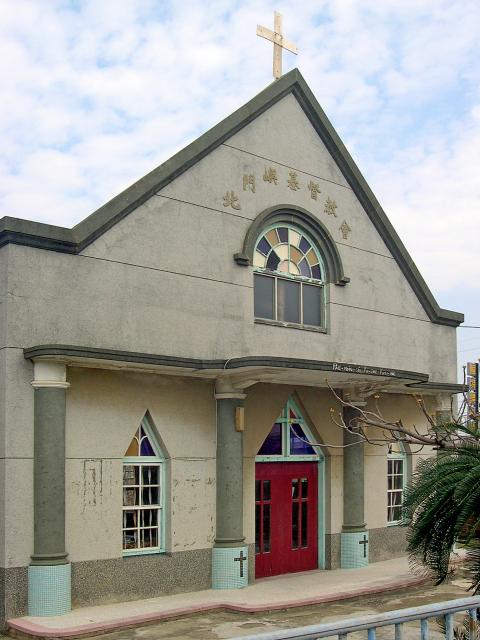
Photo: Steve Crook
ST. JOSEPH’S CHURCH
Driving south from Donghouliao on Highway 19 brings you to the busiest part of Yijhu. There, at 423-1 Renli Village (仁里), you’ll find St. Joseph’s Church (聖若瑟堂). This Roman Catholic hall of worship was constructed in 1960 to serve a congregation that had formed a few years earlier. During this period, the Catholic church in Taiwan experienced rapid growth, in large part because of an influx of priests, nuns and lay believers from China.
The exterior and interior of St. Joseph’s Church are quite plain, certainly in comparison to the next church on our tour. Taking Highway 19 into Tainan will bring you to Yanshui (鹽水), a town best known for its Beehive Fireworks Festival, an annual event closely tied to popular folk religion.
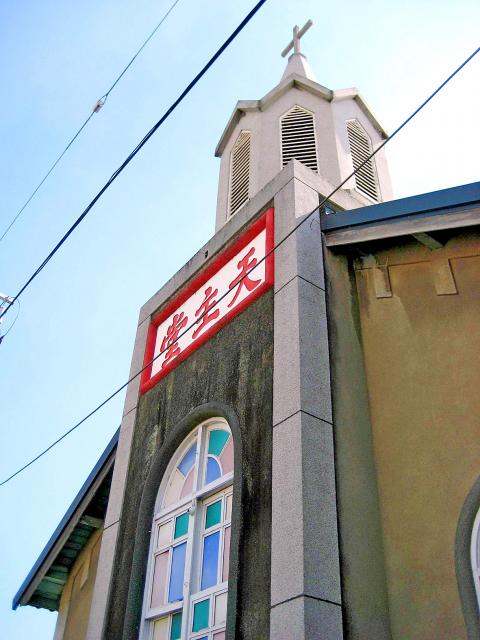
Photo: Steve Crook
HOLY TRINITY CATHOLIC CHURCH
Holy Trinity Catholic Church (鹽水天主堂) is at 19 Simen Road, close to where you can catch a bus from Yanshui to Budai (布袋) via Yijhu, or to the railway station at Sinying (新營). The pale yellow walls and bell tower aren’t much of a hint as to what can be seen within. However, the roof does somewhat resemble that of a local temple, and the apparel of those shown in the mural of Jesus and his followers is distinctly Chinese.
The interior is nothing short of breathtaking. The longer you linger, the greater your wonderment. On the wall behind the altar, there’s a large illustration inspired by da Vinci’s The Last Supper. In this depiction of Christ and his apostles, each man sports Asian facial features and traditional Chinese clothes. Most of them are bearded like the sages of ancient China, and they sit at a table loaded with chopsticks and plates of steamed buns.
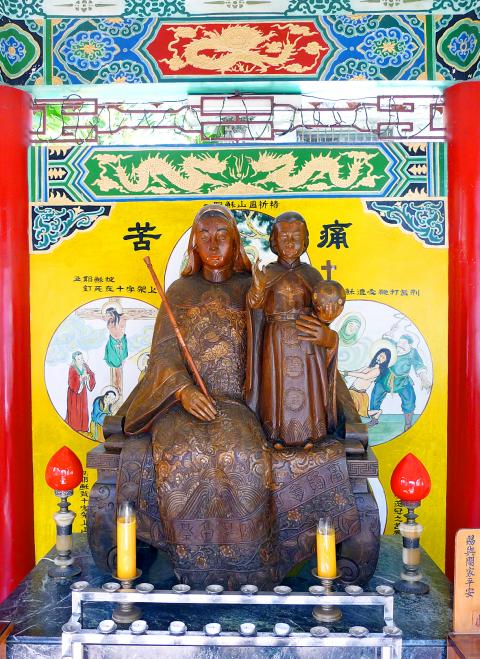
Photo: Steve Crook
In this church’s version of the Feeding of the Multitude, the tree looks very much like those which appear in classical Chinese landscape paintings. There are localized images of the crucifixion, but most striking of all is the dignified individual who looks down over the worshipers from the rear wall. He has a “vast, protruding, bulbous forehead, big ears, long drooping eyebrows, white beard and [a] plump, robe-clad figure.” Those words — written about the Chinese god of longevity, Lao Shouxing (老壽星), by Patricia Bjaaland Welch in her book Chinese Art: A Guide to Motifs and Visual Imagery — perfectly describe this depiction of the Christian deity.
Does any of this deviate too far from the conventions of Western religious art? Not according to Catholic author Angelo Stagnaro. In a May 2017 blog post for the National Catholic Register, he gushes about the church, stressing: “Every aspect of the traditional Taoist temple is replicated, baptized and made Christian all for the greater glory of God.”
Steven Crook has been writing about travel, culture, and business in Taiwan since 1996. Having recently co-authored A Culinary History of Taipei: Beyond Pork and Ponlai, he is now updating Taiwan: The Bradt Travel Guide.
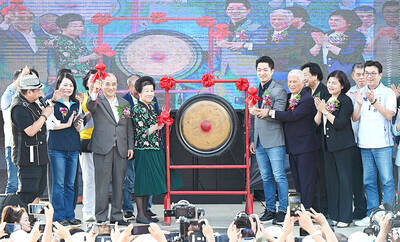
The 1990s were a turbulent time for the Chinese Nationalist Party’s (KMT) patronage factions. For a look at how they formed, check out the March 2 “Deep Dives.” In the boom years of the 1980s and 1990s the factions amassed fortunes from corruption, access to the levers of local government and prime access to property. They also moved into industries like construction and the gravel business, devastating river ecosystems while the governments they controlled looked the other way. By this period, the factions had largely carved out geographical feifdoms in the local jurisdictions the national KMT restrained them to. For example,

The remains of this Japanese-era trail designed to protect the camphor industry make for a scenic day-hike, a fascinating overnight hike or a challenging multi-day adventure Maolin District (茂林) in Kaohsiung is well known for beautiful roadside scenery, waterfalls, the annual butterfly migration and indigenous culture. A lesser known but worthwhile destination here lies along the very top of the valley: the Liugui Security Path (六龜警備道). This relic of the Japanese era once isolated the Maolin valley from the outside world but now serves to draw tourists in. The path originally ran for about 50km, but not all of this trail is still easily walkable. The nicest section for a simple day hike is the heavily trafficked southern section above Maolin and Wanshan (萬山) villages. Remains of

With over 100 works on display, this is Louise Bourgeois’ first solo show in Taiwan. Visitors are invited to traverse her world of love and hate, vengeance and acceptance, trauma and reconciliation. Dominating the entrance, the nine-foot-tall Crouching Spider (2003) greets visitors. The creature looms behind the glass facade, symbolic protector and gatekeeper to the intimate journey ahead. Bourgeois, best known for her giant spider sculptures, is one of the most influential artist of the twentieth century. Blending vulnerability and defiance through themes of sexuality, trauma and identity, her work reshaped the landscape of contemporary art with fearless honesty. “People are influenced by

Ten years ago, English National Ballet (ENB) premiered Akram Khan’s reimagining of Giselle. It quickly became recognized as a 21st-century masterpiece. Next month, local audiences get their chance to experience it when the company embark on a three-week tour of Taiwan. Former ENB artistic director Tamara Rojo, who commissioned the ballet, believes firmly that if ballet is to remain alive, works have to be revisited and made relevant to audiences of today. Even so, Khan was a bold choice of choreographer. While one of Britain’s foremost choreographers, he had never previously tackled a reimagining of a classical ballet, so Giselle was